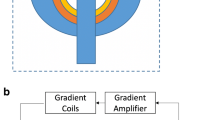Abstract
Objective
The study is to assess the accuracy and reliability of 3D simulated magnetic resonance imaging with SPACE sequence for estimating implant volume and reconstructing implant deformation, which may assist in the diagnosis of implant complications and making individualized surgical plans for these patients.
Methods
MRI examinations of ten silicone implants were performed with T2, H2O-excitation SPACE sequence (T2-spc-H2O) and silicone-excitation SPACE sequence (T2-spc-Silicone) to find the most accurate method to estimate implant volume by ITK-SNAP. The effect of implant deformation and voxel size of silicone-excitation SPACE sequence on volume measurement was investigated. Thirteen normal patients and ten patients with implant complications (Wuhan Tongji Hospital from March 2017 to May 2019) were enrolled for testing the accuracy and reliability of 3D simulated MRI with silicone-excitation SPACE sequences for volume measurement and reconstructing implant deformation in patients.
Results
The absolute volume differences of T2-spc-Silicone group were significantly less than T2-spc-H2O and T2 group (6.28 vs. 23.27 vs. 42.19 mL, P < 0.05) in vitro. No significant difference was found between the normality group and the deformation group for estimating the volume of implants. Besides, the voxel size of T2-spc-Silicone from 0.5 × 0.5 × 0.5 mm to 5.0 × 5.0 × 5.0 mm did not significantly affect the accuracy of volume measurement of the implants in deformation state. However, 3D images of the implant became blurred with the voxel size increased. With the voxel size larger than 1.5 × 1.5 × 1.5 mm, the scores of image quality decreased significantly. The number of folds could not be identified accurately with the voxel size larger than 2.0 × 2.0 × 2.0 mm. In normal patients, the measurement errors of T2-spc-Silicone were around 10 mL. In the patients with implant complications, there was no significant difference between measured volume and the actual volume of implants. Moreover, implant deformations were clearly presented by T2-spc-Silicone with the voxel size of 1.0 × 1.0 × 1.0 mm. The results showed excellent intraobserver reliability (ICC = 0.997 > 0.8), and internal consistency ranged from 0.986 to 0.997 (P < 0.001).
Conclusions
The method to measure implant volume by 3D simulated magnetic resonance imaging with T2-spc-Silicone sequence had possessed desirable accuracy and reliability. The deformation of the implant and the voxel size of the T2-spc-Silicone sequence didn’t exhibit a significant effect on the accuracy of the measurement. T2-spc-Silicone with voxel size less than 2.0 × 2.0 × 2.0 mm could be used for 3D reconstruction of the implant deformation. The 1.0 × 1.0 × 1.0 mm was a suitable voxel size to reconstruct implant deformation clearly and quickly.
Level of Evidence IV
This journal requires that authors assign a level of evidence to each article. For a full description of these Evidence-Based Medicine ratings, please refer to the Table of Contents or the online Instructions to Authors www.springer.com/00266.
















Similar content being viewed by others
References
Gabriel A, Maxwell GP (2015) The evolution of breast implants. Clin Plast Surg 42(4):399–404
Steinbach BG et al (1993) Breast implants, common complications, and concurrent breast disease. Radiographics 13(1):95–118
Headon H, Kasem A, Mokbel K (2015) Capsular contracture after breast augmentation: an update for clinical practice. Arch Plast Surg 42(5):532–543
Spear SL, Baker JL Jr (1995) classification of capsular contracture after prosthetic breast reconstruction. Plast Reconstr Surg 96:1119–1123
Chung KC et al (2012) Economic analysis of screening strategies for rupture of silicone gel breast implants. Plast Reconstr Surg 130(1):225–237
Mineyev M et al (1995) Measurement of breast implant volume with magnetic resonance imaging. Ann Plast Surg 34(4):348–351
Akbas H et al (2004) Estimation of breast prosthesis volume by the Cavalieri principle using magnetic resonance images. Aesthet Plast Surg 28(5):275–280
Rudolph R, Forcier N (2009) Calculation of silicone breast implant volumes using breast magnetic resonance imaging. Aesthet Surg J 29(4):310–313
Fritz J et al (2016) Six-fold acceleration of high-spatial resolution 3D SPACE MRI of the knee through incoherent k-space undersampling and iterative reconstruction first experience. Investig Radiol 51(6):400–409
Yushkevich PA et al (2006) User-guided 3D active contour segmentation of anatomical structures: significantly improved efficiency and reliability. Neuroimage 31(3):1116–1128
Author information
Authors and Affiliations
Corresponding author
Ethics declarations
Conflict of interest
The authors declare that they have no conflict of interest to disclose.
Ethical Approval
All procedures performed in studies involving human participants were in accordance with the ethical standards of the institutional and/or national research committee and with the 1964 Helsinki Declaration and its later amendments or comparable ethical standards.
Informed Consent
For this type of study, informed consent is not required.
Additional information
Publisher's Note
Springer Nature remains neutral with regard to jurisdictional claims in published maps and institutional affiliations.
Rights and permissions
About this article
Cite this article
Wang, D., Xiong, S., Ai, T. et al. Imaging of the Silicone Implant with a 3D SPACE MR Sequence: The Accuracy for Estimating Implant Volume and Reconstructing Implant Deformation in Breast Surgery. Aesth Plast Surg 45, 108–117 (2021). https://doi.org/10.1007/s00266-020-01652-y
Received:
Accepted:
Published:
Issue Date:
DOI: https://doi.org/10.1007/s00266-020-01652-y




